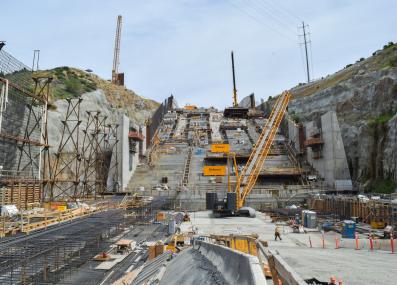Have a question?
Can taking carbon dioxide from the atmosphere and splitting it into carbon and oxygen help stem the tide of rising greenhouse gases?
While CO2 molecules can be broken down and re-used, there are some technological hurdles to clear before we can do this cheaply, put the carbon to good use, and not emit more greenhouse gases in the process.
July 11, 2022
Let’s break this question into two parts: first, pulling CO2 out of the atmosphere, and then splitting the CO2 molecules.
The use of technology to pull CO2 out of the atmosphere is called direct air capture (DAC). Most commonly, machines suck in surrounding air and then chemically bind it with a non-toxic solution to separate out the CO2. Currently, DAC comes with high energy costs: one study estimates that the energy needed to run DAC machines as a primary climate solution would be the same as the current annual energy needs of Japan, China, the US, and the EU combined.1 To make DAC a climate solution, this energy would need to come from low- or no-carbon sources, such as wind, solar and nuclear power—which raises the question, should this massive amount of low-carbon energy be used to power DAC machines, or support our current energy needs and replace fossil fuels? Because of the complications this creates, DAC has been cited by the Intergovernmental Panel on Climate Change (IPCC) as just one of a suite of technologies and practices for limiting global warming to 2°C.2
CO2 splitting has also gained interest among those who want to capture CO2 before it goes into the atmosphere. A suite of technologies called carbon capture, utilization, and storage (CCUS) can be used to capture CO2 from major land-based sources, like factories or power plants. CCUS is potentially a way to eliminate the carbon emissions of otherwise hard-to-decarbonize industries, like making chemicals and steel.
Captured CO2—from DAC or CCUS—can be dealt with in a number of ways: compressed and stored underground, or injected into the ground to extract oil (called “enhanced oil recovery,” which isn’t a climate solution). Or it can be used for other purposes, which does, often, require the CO2 molecules to be split.
When split, CO2 separates into carbon monoxide and oxygen. (You don't generally get pure carbon, which is a bit of an obstacle because carbon monoxide is poisonous and a troublesome pollutant in its own right.) These molecules are not greenhouse gases, so they don’t warm the atmosphere. And they can be used as building blocks for making synthetic fuels, such as methanol, low sulfur diesel, butane, propane, and jet fuel, and even building supplies. In fact, there is a $20 million XPrize competition that funds projects that can turn CO2 into usable products.
However, the current process for splitting CO2 requires high temperatures (1300° F/700° C or more) to spark a series of chemical reactions that cause the molecules to separate. This process is energy-intensive, and currently accomplished by burning fuels that—guess what—emit more greenhouse gases.
Scientists are, however, exploring low-carbon ways of splitting CO2. For example, James Miller, a chemical engineer and professor at Arizona State University’s Global Institute of Sustainability and Innovation, is part of a team that’s designing a new thermal chemical reactor that would use solar energy to split CO2 molecules. The reactor would mimic photosynthesis by using concentrated solar thermal energy (that is, heat from the sun), water, and CO2 captured from smokestacks (not the atmosphere), to produce liquid, energy-dense hydrocarbon fuels.
CO2 molecules can be split through a few other processes, too. Some methods are actually low-carbon, using new chemical catalysts or photocatalysts to trigger chemical reactions that can break apart CO2 without applying high heat.3,4
One benefit of splitting CO2 is that it creates a financial incentive for pulling excess CO2 out of the atmosphere (DAC) or capturing it from smokestacks (CCUS), since the captured CO2 can be used to create marketable products. Another benefit is that these molecules might one day be used to create cleaner high-energy fuels, as is the aim of Prof. Miller’s reactor.
But until low-carbon energy sources can be used on a large scale to both capture and split CO2, the process won't be a major climate solution. The role that splitting CO2 will play in the climate mitigation puzzle hinges on whether (and how) researchers overcome the energy challenges involved in DAC and CCUS, and turn the CO2 into products that are cost-competitive on the market. At the moment, there’s no clear best solution to that problem, Miller says. “It comes down to, not only the science, but which technology develops the fastest, politics, and the ethics.”
1 Realmonte, G., Drouet, L., Gambhir, A. et al. "An inter-model assessment of the role of direct air capture in deep mitigation pathways." Nature Communications, vol. 10, July 2019. doi:10.1038/s41467-019-10842-5
2 Intergovernmental Panel on Climate Change: "Climate Change 2022: Mitigation of Climate Change."
3 Xu, H., Rebollar, D., He, H. et al. "Highly selective electrocatalytic CO2 reduction to ethanol by metallic clusters dynamically formed from atomically dispersed copper." Nature Energy, vol. 5, August 2020. doi:10.1038/s41560-020-0666-x
4 Wang, C., Yang, WC.D., Raciti, D. et al. "Endothermic reaction at room temperature enabled by deep-ultraviolet plasmons." Nature Materials, vol. 20, March 2021. doi:10.1038/s41563-020-00851-x









